Azure Multi-Factor Authentication reduces organizational risk and helps enable regulatory compliance by providing an extra level of authentication, in addition to a user’s account credentials, to secure employee, customer, and partner access.
Azure Multi-Factor Authentication
Images
Check Software Images

Customer Reviews
Azure Multi-Factor Authentication Reviews
David L.
Advanced user of Azure Multi-Factor AuthenticationWhat do you like best?
We tried to use Azure MFA on our Azure AD and Azure AD B2C tenant.
It's easy to set up, just need to check the MFA option on your login policy. Then you need to get cell phone numbers on each user profile.
What do you dislike?
There is no way to combine some users with MFA and some users with a standard authentification (We don't have all customer mobile phone).
Sometimes the Azure Portal is not responding well : the website is slow and some tasks failed.
Azure is providing some customisation on their login page but some text or fields cannot be changed.
Recommendations to others considering the product:
Azure Authent is easy to implement and configure, the standard version is free if you have a small volume of users and login.
But there is several limitations.
Be careful when implementing this product : we don't find a way to mix MFA and single factor authentification
Azure premium subscribtion is needed if you want to get automatic suspicious connexions alert and if you want more than 7 days of login history.
What problems are you solving with the product? What benefits have you realized?
We hope to add more security on our authentification, to prevent unauthorized access, fishing, piracy.
We actually not activate MFA for customers for the moment but we hope to do this in the next month.
Multifactor helps customer to renew their forgotten password as a self service. With a single authentification process, we dont able users to reset their password by their own.














